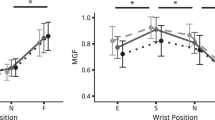Abstract
Macaques have been used as an important paradigm for understanding the neural control mechanisms of human precision grip capabilities. Therefore, we dissected the forearms and hands of two male Japanese macaques to systematically record the muscle mass, fascicle length and physiological cross-sectional area (PCSA). Comparisons of the mass fractions and PCSA fractions of the hand musculature among the Japanese macaque, chimpanzee, and human demonstrated that the sizes of the thenar and hypothenar eminence muscle groups are more balanced in the macaque and chimpanzee, but those of the thenar eminence group are much larger in the human, indicating that the capacity to generate force at the tip of the thumb is more restricted in macaques, despite their high manual dexterity. In the macaque, however, the extrinsic flexor muscles are much larger, possibly to facilitate weight bearing by the forelimbs in pronograde quadrupedal locomotion and forceful grasping of arboreal supports in gap-crossing movements such as leaping. Taking such anatomical differences imposed on the hand musculoskeletal system into consideration seems to be an important method of clarifying the mechanisms of precision grip in macaques.
Similar content being viewed by others
References
Ajiri T (1981) A comparative study on muscle fiber organization in human hand muscles. J Showa Med Assoc 41:693–706 (in Japanese with English abstract)
Alstermark B, Pettersson LG, Nishimura Y, Yoshino-Saito K, Tsuboi F, Takahashi M, Isa T (2011) Motor command for precision grip in the macaque monkey can be mediated by spinal interneurons. J Neurophysiol 106:122–126
Aziz MA, Dunlap SS (1986) The human extensor digitorum profundus muscle with comments on the evolution of the primate hand. Primates 27:293–319
Bennett KMB, Lemon RN (1996) Corticomotoneuronal contribution to the fractionation of muscle activity during precision grip in the monkey. J Neurophysiol 75:1826–1842
Brand PW, Beach RB, Thompson DE (1981) Relative tension and potential excursion of muscles in the forearm and hand. J Hand Surg Am 6:209–219
Chan SS, Moran DW (2006) Computational model of a primate arm: from hand position to joint angles, joint torques and muscle forces. J Neural Eng 3:327–337
Chao EYS, An KN, Cooney WP, Linscheid RL (1989) Biomechanics of the hand, a basic research study. World Scientific, Singapore
Chatani K (2003) Positional behavior of free-ranging Japanese macaques (Macaca fuscata). Primates 44:13–23
Cheng EJ, Loeb GE (2008) On the use of musculoskeletal models to interpret motor control strategies from performance data. J Neural Eng 5:232–253
Hartman CG, Straus WL (eds) (1969) The anatomy of the rhesus monkey (Macaca mulatta). Hafner, New York
Homma T, Sakai T (1994) Intrinsic hand muscles of the Japanese monkey, Macaca fuscata. Anthropol Sci 102:85–95
Jacobi U (1966) Die Musklatur des Unterarnes und der Hand bei Macaca mulatta. Z Morph Anthrop 58:48–73
Kimura K, Takai S (1970) On the musculature of the forelimb of the crab-eating monkey. Primates 11:145–170
Mendez J, Keys A (1960) Density and composition of mammalian muscle. Metabolism 9:184–188
Muir RB, Lemon RN (1983) Corticospinal neurons with a special role in precision grip. Brain Res 261:312–316
Myatt JP, Crompton RH, Payne-Davis RC, Vereecke EE, Isler K, Savage R, D’Août K, Günther MM, Thorpe SKS (2012) Functional adaptations in the forelimb muscles of non-human great apes. J Anat 220:13–28
Ogihara N, Kunai T, Nakatsukasa M (2005) Muscle dimensions in the chimpanzee hand. Primates 46:275–280
Ogihara N, Makishima H, Aoi S, Sugimoto Y, Tsuchiya K, Nakatsukasa M (2009) Development of an anatomically based whole-body musculoskeletal model of the Japanese macaque (Macaca fuscata). Am J Phys Anthropol 139:323–338
Oishi M, Ogihara N, Endo H, Asari M (2008) Muscle architecture of the upper limb in the orangutan. Primates 49:204–209
Oishi M, Ogihara N, Endo H, Ichihara N, Asari M (2009) Dimensions of forelimb muscles in orangutans and chimpanzees. J Anat 215:373–382
Sasaki S, Isa T, Pettersson LG, Alstermark B, Naito K, Yoshimura K, Seki K, Ohki Y (2004) Dexterous finger movements in primate without monosynaptic corticomotoneuronal excitation. J Neurophysiol 92:3142–3147
Schieber MH, Rivlis G (2005) A spectrum from pure post-spike effects to synchrony effects in spike-triggered averages of electromyographic activity during skilled finger movements. J Neurophysiol 94:3325–3341
Takei T, Seki K (2008) Spinomuscular coherence in monkeys performing a precision grip task. J Neurophysiol 99:2012–2020
Takei T, Seki K (2010) Spinal interneurons facilitate coactivation of hand muscles during a precision grip task in monkeys. J Neurosci 30:17041–17050
Tanaka I, Takefushi H (1993) Elimination of external parasites (lice) is the primary function of grooming in free-ranging Japanese macaques. Anthropol Sci 101:187–193
Acknowledgments
We are grateful to two anonymous reviewers for their helpful and constructive comments on this manuscript. This study was supported by a Grant-in-Aid for Scientific Research (no. 22656063) from the Japan Society for the Promotion of Science, and in part by the Cooperation Research Program of the Primate Research Institute, Kyoto University.
Author information
Authors and Affiliations
Corresponding author
About this article
Cite this article
Ogihara, N., Oishi, M. Muscle dimensions in the Japanese macaque hand. Primates 53, 391–396 (2012). https://doi.org/10.1007/s10329-012-0309-3
Received:
Accepted:
Published:
Issue Date:
DOI: https://doi.org/10.1007/s10329-012-0309-3



